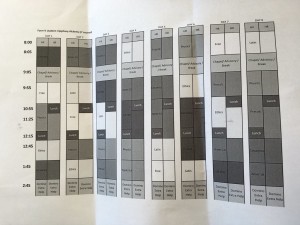Sarah Barr ’16: “No plan, no actual practice, is going to feel…radically different” stated Dr. Cathy Hall, Assistant Head of School, at a meeting regarding the change from the current schedule – which revolves around a 12 day cycle with seven 40-minute periods – to an eight day cycle with five blocks a day, where classes are either 60 or 80 minutes long.
Hall explained the multitude of changes would still bear resemblance to the traditional Episcopal schedule, because “our day to day, for the most part, is going to feel relatively similar.” The change in cycle length from 12 days – which, apparently, the “consultant thought was totally kooky” – to eight “is a little more efficient.” The idea within the new schedule is that “each class will end up meeting five out of those eight days.” Dr. Dinkins, Head of Upper School, seconded this efficiency impact of the new schedule rotation, saying that “having an eight day schedule cuts down on fragmentation during the day.”
At the start of the meeting, in response to student questions, both Hall and Dinkins addressed the valid issues regarding free periods during the day. According to Hall, “students can’t have more than seven classes, most have six, which means right out of the gate you’ve got two out of those eight opportunities that are always going to be free, on a given day, on average, you have at least one of those periods that you have free.” However, when the point of drop blocks was brought up, Dinkins stated that “the drop is built into the rotation.” This means that unlike in years past, when a block drops, students will not be given a free period in the new schedule. Instead, they just won’t have that particular class one day. The benefit of this system, seemingly, is that, as Dinkins says, “there is nothing to reclaim…it is impossible to reclaim [a drop]” since you’ll just be sitting in another class.

In regards to homework, Hall stated that “you shouldn’t be feeling the same intensity of pressure…you should have much more built in free time during most days.” Part of her reasoning in this is that the new system, while chapel still exists as its traditional 30-minute entity, will have a “break” period afterwards, which Hall says can be used “as chapel and advisory” and that there will be “a lot more opportunity for student activity.”
Relating to worry about how teachers will shift their curriculums to fit into a new system, Hall stated that she’s “taught in that kind of environment…its challenging…but it can be done really really well.” In addition, she noted that she has “a lot of faith in our faculty to be agile…our teachers are going to spend a lot of time thinking…this isn’t just a kind of ‘we have faith, go at it and good luck.’”
The point of tests was brought up by several students, to which Hall responded that she could not “envision a scenario where a teacher is giving you an 80 minute test…the idea here isn’t that now you’ve got this extra time so lets just crush students with this extra work.”
Finally, the point of the different lunch system was brought up, as two different lunch periods now exist in the model schedule. Dr. Dinkins addressed this by saying that they are working on “a scenario in which some students don’t always have the later lunch and some students don’t always have the earlier lunch…” There was no mention on if the Upper School would eat with the Middle School, or if there would continue to be separate lunch periods between the two schools.
While the changes may take getting used to, Hall has assured students that “the goal here is to actually try to help create better balance in your lives.”